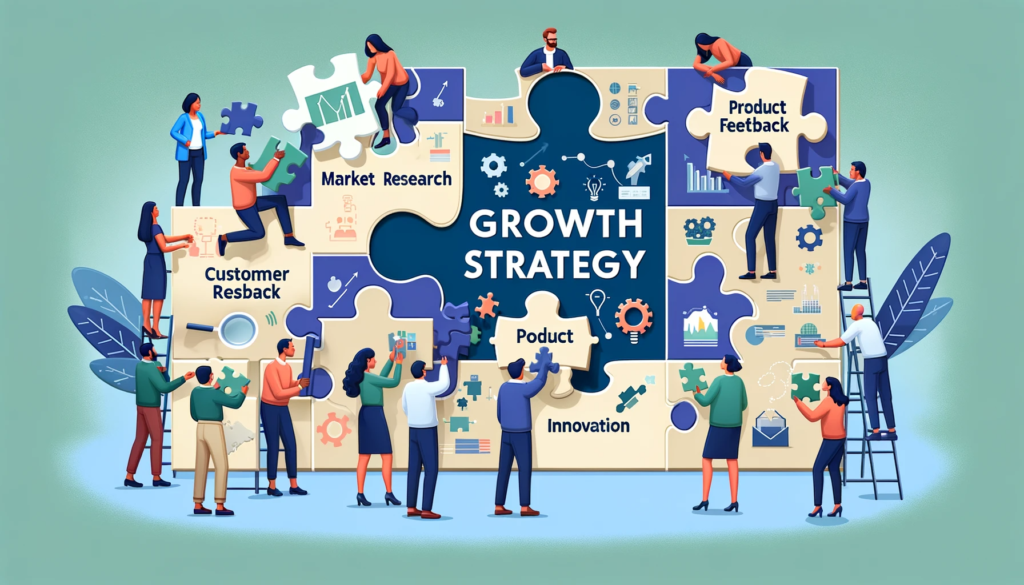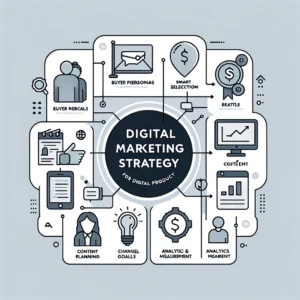The concept of growth is often shrouded in a mix of aspiration and ambiguity. For businesses aiming to scale their products, understanding how to effectively execute growth strategies is crucial. This is where the art of product growth strategy comes into play, distinguishing itself from traditional marketing approaches with its holistic and multifaceted nature.
This article delves into the realm of product growth, a field that extends beyond mere revenue increase. It encompasses the expansion of user base, enhancement of product usage, and even the development of new product lines, all aimed at elevating a product’s market position and value. Unlike standard marketing strategies that might focus on specific tactics like pay-per-click ads or search engine optimization, product growth strategies offer a comprehensive roadmap for businesses to evolve from their current state to an envisioned future of success and innovation.
Execute Growth in Product Management

For professionals in product management and related fields, understanding how to execute growth in a product is not just about adopting new strategies; it’s about embracing a mindset that prioritizes learning from customers, adapting to market changes, and aligning product development with overarching business goals. This article aims to guide you through this journey, offering insights and actionable strategies to transform your product from a static offering into a dynamic, growth-oriented entity.
Understanding Product Growth Strategy
Definition and Significance of a Product Growth Strategy
A product growth strategy is more than a mere plan for increasing sales; it’s an actionable and comprehensive approach that helps businesses achieve a broader objective – sustainable and scalable growth. Unlike traditional marketing strategies focused on promoting products, a product growth strategy is a high-level, holistic plan that involves all departments of a company. It aims to grow a business from multiple angles, including revenue, market share, and user base, and encompasses marketing strategies as a part of a larger scheme.
This strategy is vital for companies looking to enhance their product’s value, expand their user base, and ensure that their offerings remain relevant and competitive in a constantly evolving market. It’s a scientific and systematic approach to understanding and addressing market needs, customer preferences, and product potential.
Key Differences Between a Product Growth Strategy and a Marketing Strategy
While a marketing strategy focuses primarily on promoting a product or service to increase sales or market presence, a product growth strategy goes much further. It looks at the bigger picture, seeking not just to sell a product but to expand its reach, enhance its value, and increase its usage among the target audience. This strategy involves understanding the market, identifying new user segments, innovating product features, and aligning the product with the company’s long-term goals.
In essence, a product growth strategy is an overarching plan that includes marketing tactics but also involves product development, market research, customer feedback integration, and strategic planning across multiple business facets. It’s the blueprint that guides a company in transforming its product from a simple offering to a growth-centric, market-leading solution.
Identifying the Need for a Product Growth Strategy
Determining the right time to shift gears and focus on a product growth strategy is crucial for any business. There are two primary signs that signal the need for this strategic pivot:
- Inability to Articulate Growth Plans: If your company has set overarching goals like ‘increase revenue’ or ‘grow the business,’ but lacks a clear, actionable plan to achieve these objectives, it’s time to consider a product growth strategy. This strategy will provide the roadmap and specific actions needed to turn these broad goals into attainable targets.
- Stalled Growth: When your current growth strategy begins to yield diminishing returns or your product’s market impact plateaus, it’s a clear indication that your existing approach has reached its peak. At this juncture, introducing a new product growth strategy can rejuvenate your product’s presence in the market and open new avenues for expansion.
Recognizing these signs early can help a business transition smoothly to a more effective product growth strategy, ensuring continuous improvement and adaptation in a competitive market. It’s about moving from a state of stagnation to one of proactive growth and innovation.
Steps to Creating a Successful Product Execute Growth
Creating a robust product growth strategy can feel overwhelming, given the numerous facets of a business that contribute to its success. However, by breaking down this process into manageable steps, you can develop a coherent and effective strategy. Here are five essential steps to guide you:
A. Setting High-Level Goals
Setting ambitious yet achievable goals is the starting point of any effective growth strategy. These goals should be specific, measurable, and aligned with the long-term vision of the business. Think of them as your North Star, guiding all strategic decisions and actions. Business expert Jim Collins refers to these as “big, hairy, audacious goals” (BHAGs), emphasizing their importance in driving significant growth and change.
B. Identifying Inputs and Outputs
Once your goals are set, the next step is to identify the key performance indicators (KPIs) that will track your progress. This involves understanding the inputs (resources, efforts, investments) and the expected outputs (growth in revenue, market share, user base). These KPIs serve as critical metrics to gauge the effectiveness of your growth strategy.
C. Running Growth Experiments
Growth is often a result of experimentation and learning. This stage involves designing and implementing experiments to test various growth hypotheses. It’s essential to adopt an agile approach, breaking down larger projects into minimum viable tests (MVTs) to quickly gather insights and determine the feasibility of broader initiatives.
D. Validating Growth Experiments
Not all experiments will yield positive results. This phase is about validating the findings from your growth experiments and determining their impact on customers and the business. It involves analyzing data, gathering customer feedback, and assessing whether these experiments align with your overall growth objectives.
E. Fostering Extreme Accountability
The final step in crafting a successful growth strategy is ensuring that every team member understands their role and how their work contributes to the high-level goals of the company. This step is about creating a culture of accountability and alignment, ensuring that all efforts are directed towards the common objective of growth.
By following these steps, businesses can create a structured and effective framework for driving product growth, ensuring that every action taken is a step towards achieving their overarching growth objectives.
Key Strategies for Product to Execute Growth

Developing a successful product growth strategy involves choosing the right combination of tactics. Here are four key strategies that can significantly contribute to product growth:
A. Expanding User Base
One of the most straightforward strategies for product growth is to increase your user base within your current market. This can be achieved by targeting new user segments or increasing the penetration among existing users. It’s crucial to have a solid understanding of your product-market fit and to identify adjacent user segments that could benefit from your product.
B. Acquiring New Customers
Growth can also be fueled by acquiring customers in new markets. This strategy requires exploring and understanding new industries, personas, and use cases that align with your product. Entering new markets involves iterative learning and minor, agile updates, ensuring that your product resonates with the new audience without a substantial initial investment.
C. Increasing Product Usage
Encouraging existing customers to use your product more frequently is a highly effective growth strategy. This can be achieved by adjusting pricing or bundled features, enhancing user engagement, or upselling current accounts. The goal is to make your product an integral part of the customer’s routine or business operations.
D. Developing New Products
Innovation is key to sustained growth. This strategy involves creating new products or features that address unmet needs within your target market. Utilizing customer feedback and data-driven insights can guide the development of new offerings that complement your existing product line and open up additional revenue streams.
Each of these strategies requires a deep understanding of your customers, market, and product capabilities. By effectively implementing these strategies, businesses can achieve significant growth and strengthen their market position.
Aligning Execute Growth Strategies with Business Objectives
A critical aspect of executing growth in a product is ensuring that your growth strategies align with the broader business objectives and company values. This alignment is essential for creating a cohesive and sustainable growth plan.
- Balancing User Needs and Business Goals: It’s vital to strike a balance between what is beneficial for the users and what works for the company. For instance, if your business focuses on customer retention, it might not be prudent to invest heavily in new market segments until you’ve solidified your base. Equally, if your company values simplicity, any new initiatives or product features should align with this principle, avoiding overly complex solutions that could detract from the user experience.
- Strategic Alignment with Company Values: Your product growth strategy should reflect and reinforce your company’s core values. Whether it’s innovation, customer-centricity, or sustainability, each element of your growth strategy should contribute to these overarching principles. This alignment ensures that your growth efforts are not only successful but also resonate with your brand identity and corporate ethos.
By aligning your execute growth strategies with your business objectives and values, you can ensure that your efforts contribute positively to the company’s overall direction and reputation, creating a virtuous cycle of growth and brand strengthening.
Measuring the Feasibility of Execute Growth Strategies

An essential step in executing growth in a product is assessing the feasibility of your proposed strategies. This involves considering several factors to ensure that your growth plans are realistic and achievable with your current resources and market conditions.
- Conducting a Competitor Analysis: Before delving into new products or market segments, it’s crucial to understand the competitive landscape. A thorough competitor analysis can reveal whether there is a viable opportunity for your product to succeed and can help identify potential challenges and areas of differentiation.
- Utilizing Product Prioritization Frameworks: With numerous potential avenues for growth, it’s important to use a structured approach to prioritize initiatives. Product prioritization frameworks help in deciding which strategies are most aligned with your goals and which ones can deliver the highest impact with the resources available.
- Reviewing Resource Availability: Assessing your current resources, including team skills, technological capabilities, and financial investments, is vital. This review helps in understanding what is feasible in the short and long term and prevents overcommitment to strategies that are beyond the company’s current capacity.
By thoroughly evaluating the feasibility of your growth strategies, you can ensure that your plans are grounded in reality and are more likely to yield successful outcomes.
Gaining Organizational Buy-in for Execute Growth Strategies
Implementing a new execute growth strategy in a product is not just about having a great plan; it’s also crucial to have the support and commitment of the entire organization. Gaining this buy-in involves a few strategic steps:
- Identifying Key Stakeholders: Understanding who the stakeholders are in your growth strategy is the first step. These may include senior management, team leaders, and other departments that will be affected by or contribute to the strategy.
- Adjusting to Communication Preferences: Different stakeholders may have different preferences for how they receive and process information. Tailoring your communication to suit these preferences can significantly enhance your chances of getting their support.
- Presenting Data-Driven Insights: Backing up your strategy with qualitative and quantitative data is crucial. Showing how your proposed growth plan aligns with the company’s goals and demonstrating its potential impact with data can be persuasive.
- Building a Strong Business Case: This involves not only showcasing the potential benefits but also addressing potential risks and how they will be mitigated. A comprehensive business case helps stakeholders see the full picture and the strategic value of the proposed growth initiatives.
Gaining organizational buy-in is about creating a shared vision for growth, where all stakeholders feel involved and invested in the success of the strategy.
The Role of Team Dynamics in Execute Growth in Product
The success of a product growth strategy significantly depends on the team executing it. Understanding and effectively managing team dynamics is crucial in this process.
- Identifying Team Roles and Responsibilities: Clarity in roles and responsibilities ensures that each team member knows what is expected of them. This clarity helps in aligning individual efforts with the overall growth strategy.
- Assessing Resource and Time Constraints: Each team member may have different time and resource constraints. It’s important to understand these limitations to effectively plan tasks and set realistic deadlines.
- Fostering Collaboration: A growth strategy often requires cross-departmental collaboration. Creating an environment where different teams can work together seamlessly is key to the smooth execution of growth plans.
- Adopting the Design-Thinking Process: Utilizing a design-thinking approach helps in empathizing with users, defining problems accurately, ideating solutions, prototyping, and testing with users. This process ensures that the team remains user-centric and agile in its approach.
By focusing on these aspects of team dynamics, you can create a more cohesive and effective team that is well-equipped to drive the product’s growth.
Developing a Timeline for Execute Growth
A well-defined timeline is critical for the successful execution of a product growth strategy. It helps in prioritizing tasks, aligning team efforts, and tracking progress towards your goals.
- Establishing Start Dates and Milestones: Determine when you will start implementing your growth strategy and set key milestones. These milestones act as checkpoints to assess progress and make necessary adjustments.
- Anticipating Duration for Each Phase: Estimate how long each tactic or phase of your growth strategy will take. This helps in resource planning and provides a realistic view of the growth journey.
- Scheduling Regular Check-ins with Teams: Regular check-ins with different teams involved in the growth strategy are essential. These meetings are opportunities to review progress, address challenges, and ensure alignment with the overall goals.
- Setting Goal Achievement Timelines: Define when you expect to hit your growth goals. These timelines should be ambitious yet realistic, taking into account the complexity of tasks and market dynamics.
A well-planned timeline not only keeps the growth strategy on track but also ensures that all stakeholders are synchronized in their efforts towards achieving the product growth objectives.
Tracking Growth Metrics and Outcomes
Monitoring and analyzing the right metrics in execute growth is essential to understand the effectiveness of your product growth strategy. These metrics provide insights into what is working and what needs adjustment.
- Key Metrics to Track: Depending on your specific growth strategy and goals, some of the important metrics to track might include Customer Acquisition Cost (CAC), Monthly Recurring Revenue (MRR), churn rate, Customer Lifetime Value (LTV), and free trial conversion rate. These metrics give a comprehensive view of the impact of your growth efforts.
- Analyzing and Interpreting Data: Regularly analyzing these metrics helps in understanding trends, identifying areas of success, and pinpointing aspects that require improvement. It’s important to look beyond the numbers and interpret what they imply about customer behavior and product performance.
- Adjusting Strategies Based on Insights: Use the insights gathered from these metrics to refine and adjust your growth strategies. This iterative process ensures that your strategies remain relevant and effective in achieving your goals.
- Communicating Metrics to Stakeholders: Sharing these metrics with stakeholders keeps everyone informed about the progress and helps in maintaining alignment with the company’s broader objectives.
By effectively tracking and analyzing growth metrics, you can make data-driven decisions that enhance the success of your product growth initiatives.
Conclusion of How to execute growth in a product?
Executing growth in a product is a multifaceted and dynamic process that requires a strategic approach, team collaboration, and continuous adaptation. From setting clear goals and running growth experiments to fostering a culture of accountability and tracking progress through key metrics, each step plays a vital role in the journey towards achieving sustainable product growth.
Remember, the key to successful product growth lies in staying curious, being empathetic towards customer needs, and always being open to change. By aligning growth strategies with your business objectives, continuously engaging with your market, and leveraging data-driven insights, you can transform your product into a thriving and evolving entity in its marketplace.
In conclusion, the path to product growth is both challenging and rewarding. It demands a balance of strategic planning, innovative thinking, and relentless execution. By following the guidelines and strategies outlined in this article, you are well-equipped to embark on this journey, driving your product towards new heights of success and market relevance.



